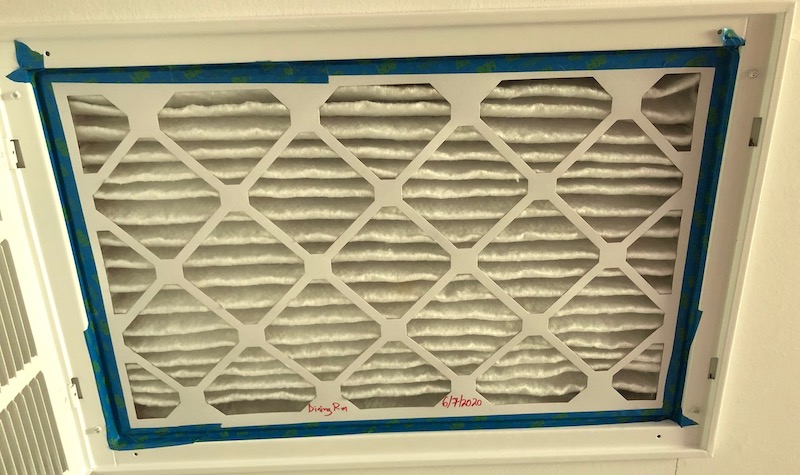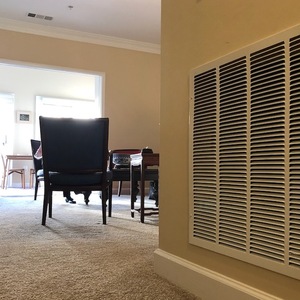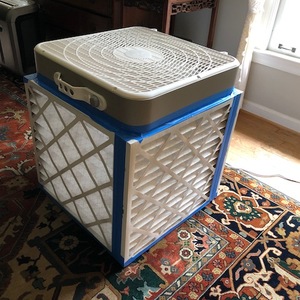
Oh, the controversies of duct design. Standard versus high-efficiency filters. Radial versus trunk and branch. Central versus dedicated return vents. Flex versus sheet metal ducts. But there’s another duct debate that centers around the location of the filter. In our HVAC design practice, we have a clear preference. The advantages of filter grilles have led us to design duct systems with the filters at the intakes.
The advantages
So, what are those advantages? Here are four:
- More filter area. We like high-efficiency (high-MERV) filters. To use them without the unintended consequences that sometimes accompany them, you have to have enough filter area. It’s often easier to do that at the intakes of the return ducts instead of at the air handler, where there’s rarely enough space.
- Easier access for filter changes. The return grilles are always in the conditioned space. (OK, that’s not completely true. Sometimes installers do stupid things, but let’s ignore that.) The air handler can be in a cramped, dirty attic or a nasty, snake-infested crawlspace with rotting possum carcasses. Where would you rather go to change the filter?
- Clean return ducts. Filtering the air before it enters the return ducts keeps those ducts clean. You’ve got to prevent bypass with tape (as shown below) or gaskets, and the return ducts have to be as airtight as possible, but that’s doable.
- Less expensive. It depends on what you install, but putting 2-in.-thick MERV-13 filters at the return grilles can be less expensive than using 4- to 6-in.-thick filters at the air handler. Having less return duct to install can cut material and labor expenses, too.

Filter grille advice
When we design the ducts for our clients, we specify filter grilles sized to have low pressure drop with MERV-13 filters. To make them effective and convenient, we do or advise the following:
- Seal the return ducts as airtight as possible. Any leaks there will pull in air that doesn’t get filtered.
- Use MERV-13 filters that are 2-in. deep. The 1-in. filters generally have higher pressure drop. Yes, thicker filters can help, too. The downside, though, is that they’re more expensive and will require more space in the ceiling or wall.
- Make them all the same size. It’s much more convenient to have only one size of filter to buy and change.
- Seal the holes, joints, and seams in the filter housing. Those holes can pull in air behind the filter, which means it won’t get filtered.
- Use tape or gaskets around the filter. Eliminate all the bypass routes and make sure all the air gets filtered.
If you’re ever faced with the choice of where to put the filter, remember these advantages of filter grilles. And once you’ve got all these HVAC debates settled in your mind, we can talk about this doozy: Air-sealed ducts versus ducts that breathe. If a house needs to breathe, shouldn’t ducts also breathe?*
_________________________________________________________________________
Allison A. Bailes III, PhD is a speaker, writer, building science consultant, and the founder of Energy Vanguard in Decatur, Georgia. He has a doctorate in physics and writes the Energy Vanguard Blog. He also has a book on building science coming out in the summer of 2022. You can follow him on Twitter at @EnergyVanguard.
* In case you’re new here, let me point out that no, a house does NOT need to breathe. And neither do ducts.
Weekly Newsletter
Get building science and energy efficiency advice, plus special offers, in your inbox.















3 Comments
Great article, great points. I'll add another:
5. Universal design - IF you install the return air grill in an accessible location such as on a wall with the top no more than 48" aff, and NOT on a ceiling. This will allow someone with less mobility to easily change the filter, and is also safer for those with full mobility. It is a MUCH better idea for your perfectly healthy and mobile 80 year old relative or self to stay off of a ladder. Giving some thought to the specific location and height off of finish floor of the return air grill can accomodate that. One of the few things I differ with Allison on is that this is a MUCH more important consideration than trying to ensure all the filters are the same size, or even ensuring the sizes are those stocked at the big box store. If making sure the filter is no more than 48" aff results in it being in a location where the size needs to change, prioritize access. Those with limited mobility or who should stay off ladders as much as possible (which is really all of us) can easily order filters online, where more sizes are available AND they are less expensive AND you can order multiples. You can store them in a closet near the return they fit, and change as needed. All done without need for a ladder and much safer.
Also, on a related note, unless return grill frames to fit 2" filters are specified, frames that will only fit 1" filters will probably be installed. Frames to fit 2" filters are difficult to source, and cost about 4x what the frames for 1" filters cost, so if it is not specified, the contractor probably won't install them.
How do you retrofit this?
A suggested article shows implementing this from an unfinished space but this doesn’t seem possible for a return vent inside a wall that’s finished on both sides. https://www.greenbuildingadvisor.com/article/designing-return-filter-grille-boxes
Log in or create an account to post a comment.
Sign up Log in